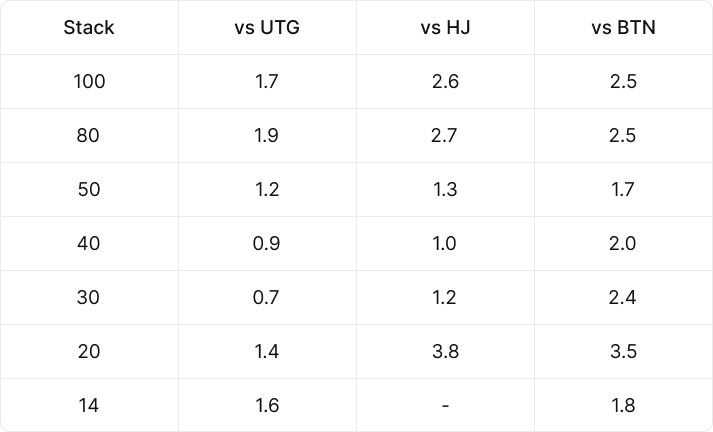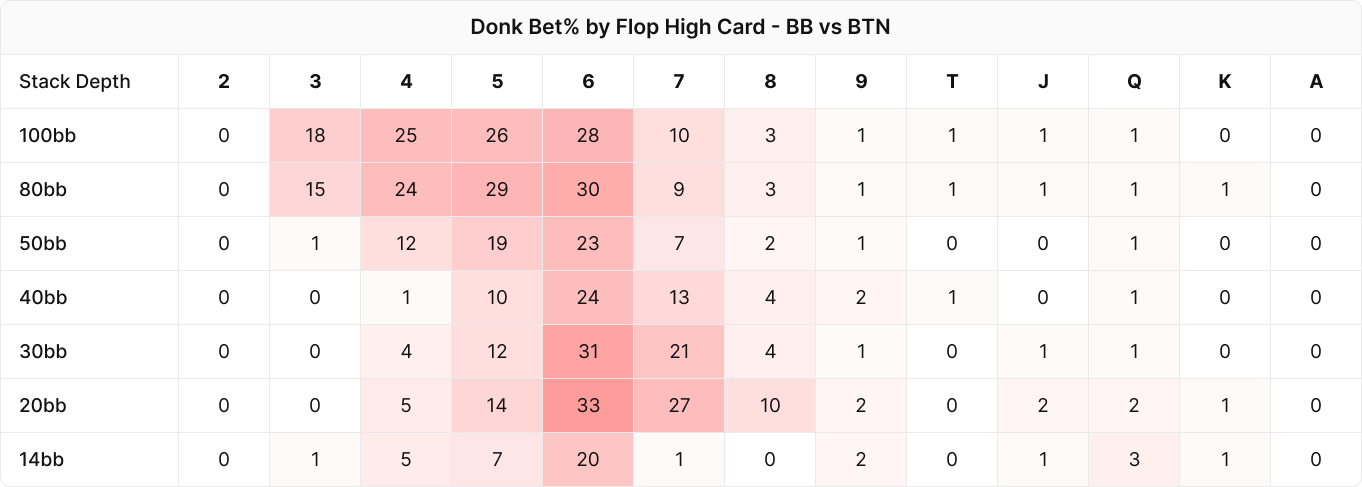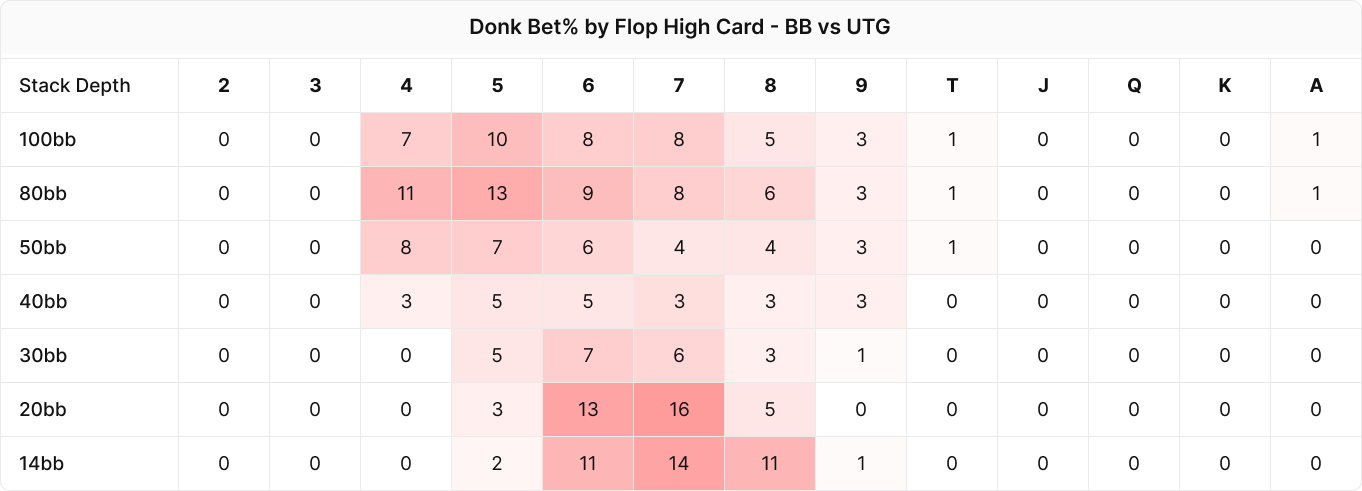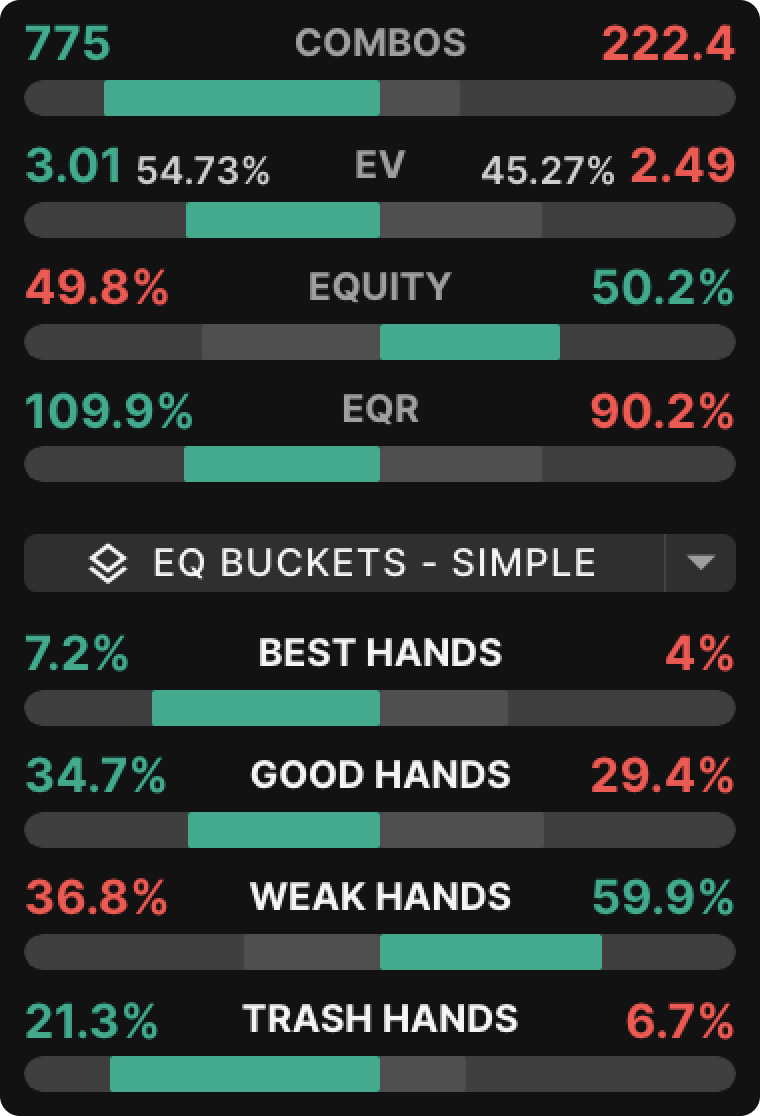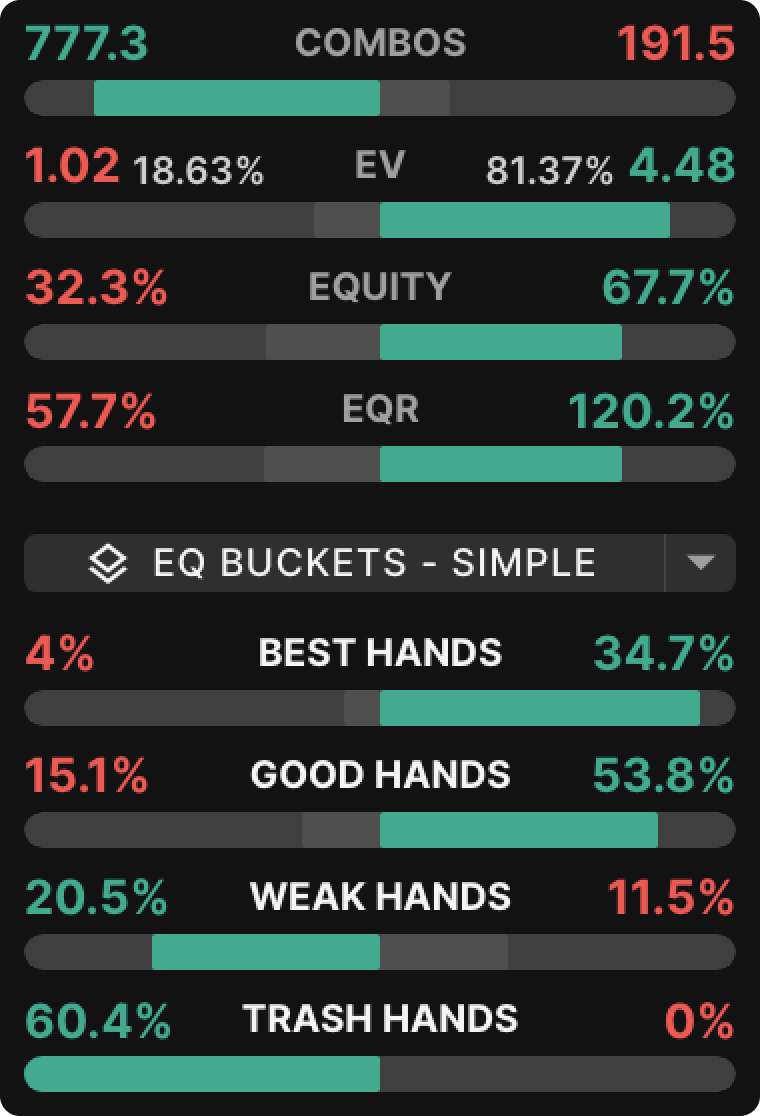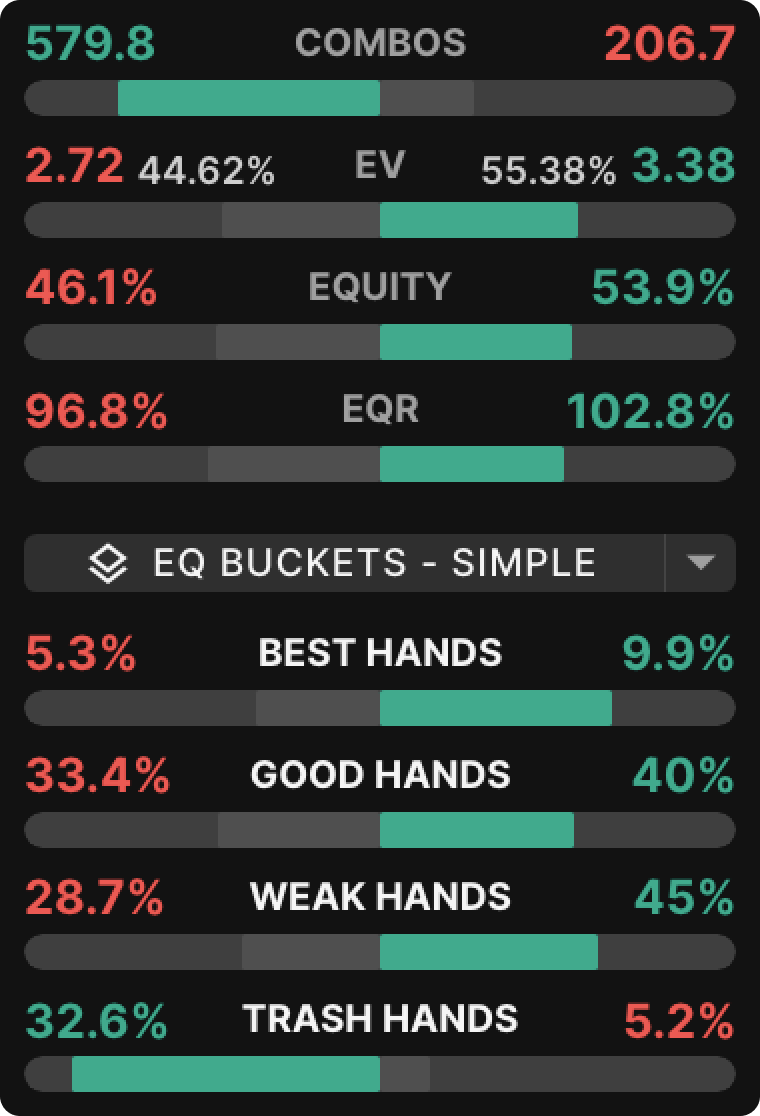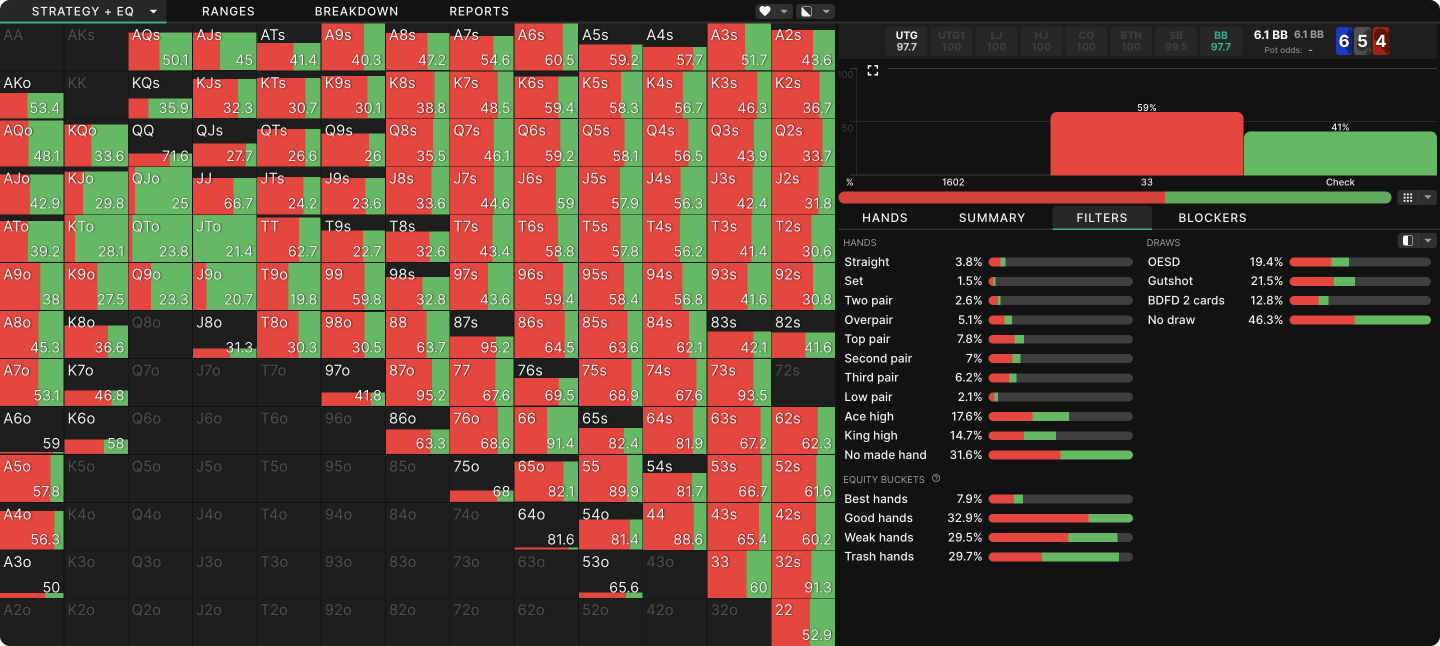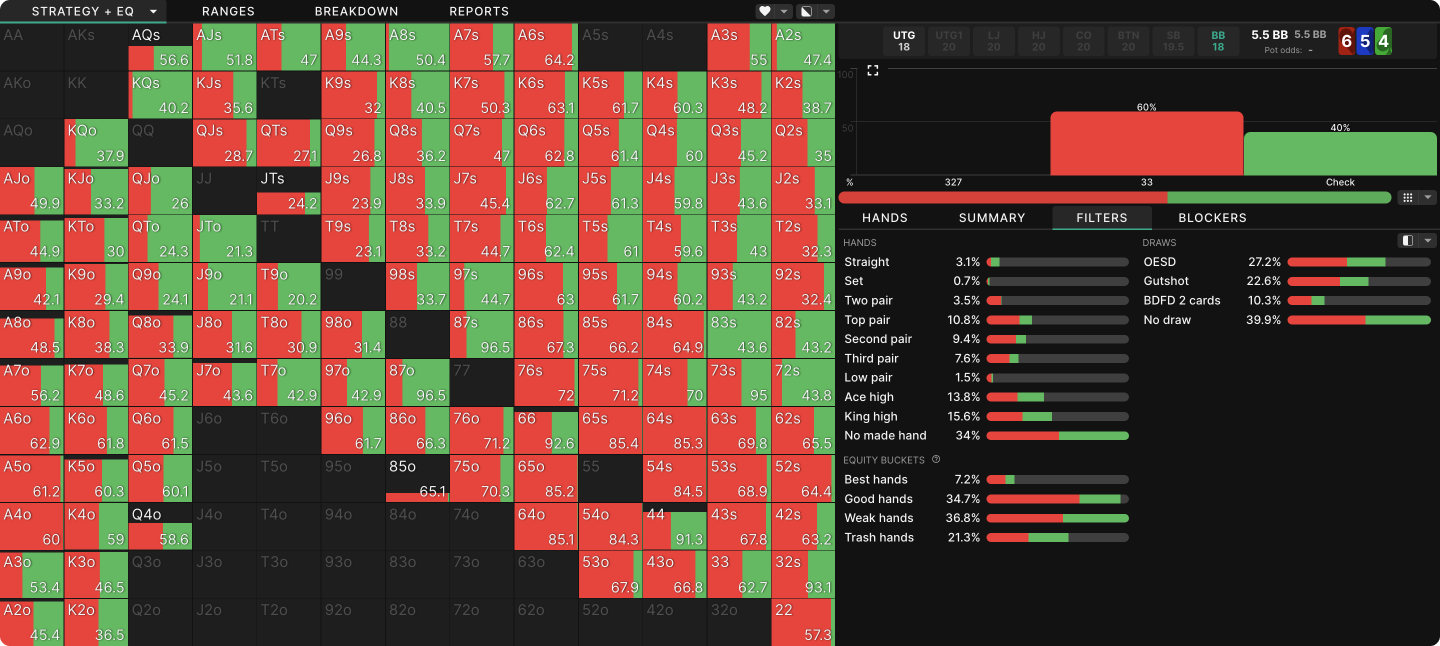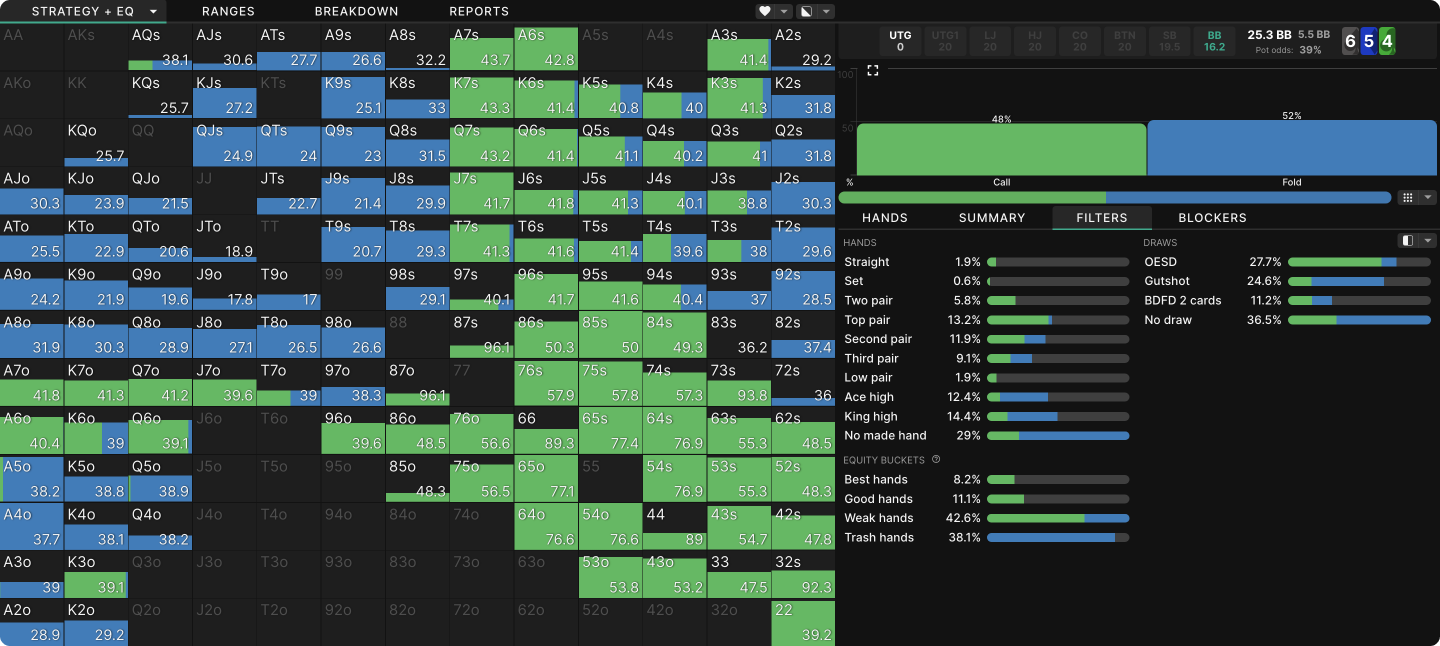Is Donk Betting for Donkeys?

“Donk betting”, or betting from out of position into the player who was the aggressorWhat is Aggression in poker?
Any bet or raise is considered an aggressive action. A player who frequently tends to bet or raise more than they check or call can be considered aggressive. on the previous street, is a derogatory term originating in poker’s younger days, when such bets were considered the hallmark of a bad player, or “donk” (short for donkey). That stereotype is not without basis in reality: betting into the previous street’s aggressor is rarely correct, so when it is done, it is often done incorrectly.
The following chart, based on data from GTO Wizard’s Flop Reports, shows the BB’sBig Blind
The minimum forced betting increment in a game of poker (bb). Can also refer to the position ‘big blind’ (BB), which is forced to put in the largest blind preflop, typically after the small blind. The big blind position acts last preflop and ats first postflop. average flop donk betting frequency at equilibrium at a variety of MTTMulti Table Tournament (MTT)
A poker tournament with at least two tables of players. stack sizes and facing opponents in early, middle, and late positions.
There appears to be slightly more donk betting as the opener’s position gets later, but even that is not true across the board. By far the most clear trend here is simply that the BB should almost never donk bet unless doing so with a clear exploitative purpose.
Donk betting should not be your top study priority, and until you are studied on it, you are better off sticking to a simple rule of never donk betting.
That doesn’t quite tell the full story, though. Here’s another chart, showing the BB’s donk betting frequency against a BTN opener, sorted by the high card on the flop.
Against the HJ
And against UTG
With the data sorted in this way, we can see there are a few flops on which donk betting is in fact a significant part of the BB’s strategy. Low card flops rarely occur, which is why the global average is so low, but when a 6- or 5-high flop does come along, it is not necessarily donkey behavior for the BB to come out betting.
That said, it is nevertheless true that donk betting is rarely correct and easy to misapply. It should not be your top study priority, and until you are studied on it, you are better off sticking to a simple rule of never donk betting. This rule will rarely lead you astray, whereas donk betting haphazardly can lead to big mistakes and exploitability.
When is Donk Betting Correct?
If you’re still reading, you’re either advanced and well-studied or stubborn (like a donkey…).
Virtually all the BB’s donk betting occurs on low card flops. The thing about 6- and 5-high flops is they are almost always connected. Low-connected boards are among the worst for the preflop raiser to continuation bet, which is where the BB gets their incentive to take the betting lead.
Donk betting occurs exclusively in situations where the BB should not expect their opponent to continuation bet often.
On boards where the preflop raiser is likely to bet anyway, there is little reason for the BB to pre-empt them. Whether the BB wishes to bet for value or as a bluff, they’d prefer to let their opponent put money into the pot with a wide, weak range first. So, donk betting occurs exclusively in situations where the BB should not expect their opponent to continuation bet often if checked to.
Two factors make a flop less desirable for continuation betting:
- The preflop raiser loses their equity advantage. A preflop raiser sees the flop with a much stronger range than a BB caller, and so has a significant equity advantage on the average flop, which enables them to bet at a high frequency and still force a lot of folds from the BB. Only very specific flops, usually low or medium-connected cards, bring the BB up to close to 50% equity.
- BB flops the nuts advantage. This doesn’t mean the literal nutsNuts
Describes the strongest possible hand on a certain board. For example, on K2789, any player holding any combination of JT is holding the nuts.. In fact, with very shallow stacks, any top pair and even some second pair can be strong enough to play as the nuts. But boards where the BB is more likely to flop sets, straights, and two pairs are harder for the preflop raiser to continuation bet because of the risk of a check-raise.
For example, here’s the range breakdown for 20bb UTG vs. BB spot on a 654r flop:
This is a spot where BB donk bets 60% of their range. Notice how the equities are almost exactly 50/50, with the BB holding more of the Best Hands and Good Hands. For comparison, here’s the same configuration on a JT9r flop, which BB never donk bets:
Which Hands Should Donk Bet?
Even after you identify a good flop for donk betting, there remains the thorny problem of which hands belong in your betting range.
The following chart shows BB’s donk betting range on a 764r flop facing an UTG opener with 20bb effective stacks. This is one of the highest frequency donk betting spots across all positions and stack sizes, so it provides a clearer picture of what makes specific hands appealing for betting.
Part of what makes donk betting so challenging to implement correctly is that many candidates are not obvious or intuitive, even in this relatively high frequency betting spot. We can start by noting some trends among BB’s betting hands, however:
- Top pair is an almost pure bet, regardless of kicker.
- Second pair is also a very high frequency bet.
- Most open-ended straight draws bet.
- There’s a lot of betting from BB’s better Ax and Kx hands.
We can also look at what kinds of hands do not bet. BB’s most consistent checks are:
- Smaller offsuit overcards (QJo, JTo).
- A2o and K2o, which not only have a weak kicker but also lack the straight draw that A3 and K3 have.
- Their very worst pairs, especially if they also have a straight draw (33 mostly checks but 22 mostly bets)
- The nuts. BB mostly checks 85, which blocks important continuing hands from UTG like 98, 88, and 87, but mostly bets 53. Slowplaying sets and two pairs is less desirable because they could easily lose action or even the entire pot to a scary turn card.
Articulating these principles provides some insight into what exactly this donk bet accomplishes. Note that it’s a small bet, just 33% of the pot. The only other bet size included in this simulation is all in, which BB never uses, so we can’t say for sure the BB would never use, say, a 75% pot bet if given the option. But a small bet from out of position ought to result in UTG rarely folding, which means BB is mostly betting hands with good equity when called but which still benefit to some degree from denying equity. In other words, there are few airball bluffs in this range. A2o and K2o are among BB’s lowest equity hands, and those are pure checks. This betting range is mostly about thin value and protection.

ATo and KTo are not simply bluffs. While they sometimes cause dominating hands like AJo and KQo to fold, they also get called by some hands they dominate, like QTs and K9s. And they deny equity to QJo, which would have not only 8 outs but also the benefit of position on later streets. By betting, these hands clean up their equity, setting them up to keep betting for value when they turn a T or to check and induce bluffs when they turn an A or K.
The danger of betting so many medium-strength hands is that it incentivizes UTG to raise. Thus, BB balances these hands that hate to get raised with hands that do very well when raised. This includes not just the sets and straights but also the 75, 65, and 54, which can shove to deny equity to UTG’s bluffs while maintaining robust equity even against the strong hands that call the shove. Most of BB’s betting range consists of hands that benefit from denying equity but also retain good equity and playability when called. Many of these hands are vulnerable to raises, so the nut hands and strong draws serve to make UTG indifferent to raising with many hands that would otherwise be good candidates.
The danger of betting so many medium-strength hands is that it incentivizes UTG to raise.
Deeper Stacks
The shallower stacks make this play more feasible for BB. Getting raised holding T7 is not so scary with an SPR of 3. BB does not actually have more of the Best Hands in their range on this flop, but they do have more Good Hands. With just 20bb, Good Hands are good enough to treat as the nuts.
With 100bb stacks, BB still does some donk betting on 764, but the frequency is reduced by nearly two-thirds. The much deeper stacks make it harder for BB to hold hands worthy of stacking off with, which in turn makes them more vulnerable to raises (or to big bets, if they don’t reserve some nutty hands for their checking range). This is partly because top pairs like T7 can no longer be played as the nuts but also because they don’t have as much 53o in their preflop calling range.
With 100bb stacks, BB has less equity and fewer Good Hands and so does less donk betting:
At 100bb effective stacks, BB’s most bet flop is 654r. The frequency is slightly lower than the 764r at 20bb, but the composition of the range is quite similar.
Once again, the main checking hands are the weaker offsuit broadways, those with no reliable outs. They lack even backdoor straight or flush draws and they risk domination when they make top pair, which is an even greater concern at this stack depth. BB likes betting their vulnerable pairs and draws for value and equity denial.
The BB’s nuts advantage – UTG has very few combos of 87, 65, and 54, and 32 and also does not have 44 at full frequency – prevents UTG from raising these bets too aggressively. BB does not donk bet this flop nearly so often against a BTN opener, who can be expected to have more of those straights and two pairs in their range.
BB does still donk bet 654r aggressively against an UTG raiser with shallower stacks, however. Here’s their 20bb strategy.
Although the donk betting frequency is similar – a bit higher, even – there are a few differences in the ranges. With 20bb stacks, BB never bets A8s or 83s, which are high frequency bets with deeper stacks. With these hands, the shorter stacks work against them, making it easier for their opponent to respond to the donk bet with a shove that would blow them off of these strong draws.
Shorter stacks work against the BB’s draws, making it easier for their opponent to respond to the donk bet with a shove that would blow them off their equity.
UTG’s equilibrium strategy with 20bb stacks is to shove about 16% of hands over BB’s donk bet. You can see from the BB’s response below that A8s is a pure fold, and that 83s has 36% equity, a bit shy of the 39% they’d need to call.
The hands that bet instead are some of the weaker offsuit overcard hands like QJo and QTo which never bet with 100bb stacks. BB does not mind folding these to a shove as much as they would mind folding 83s, and unlike with deeper stacks, they can treat these as strong hands should they turn top pair.
With deeper stacks, UTG can no longer blithely stack off with overpairs. Thus, they raise less than half as often and mostly use a smaller size. This means BB is no longer in danger of getting raised off these draws: they get raised less often, have better immediate odds to call when they are raised, and can anticipate a bigger payoff should they improve to a straight.
ICM
These charts and graphs are from ChipEV simulations; ICMICM
A commonly used acronym for the term independent chip model. ICM is a model that translates the value of a tournament chip to actual cash value, better known as tournament equity. ICM calculations are based on the stacks and payouts of all players remaining in the tournament. can dramatically change players’ incentives.
Broadly speaking, both players have less incentive to grow the pot. However, when one player is covered, they are especially disincentivized from betting. Thus, you should donk bet even less often, even on favorable boards, when you are the covered player. Conversely, when you cover your opponent, donking will be a more important part of your strategy even in spots that seem otherwise undesirable for it. This article explores these concepts in greater detail.
Conclusion
For BB to make substantial use of the donk bet option, three conditions must adhere:
- Equities run close enough that the preflop raiser cannot be expected to continuation bet the flop at a high frequency. BB does not require an equity advantage, but they should not be at a significant disadvantage.
- The board is dynamic, causing BB to value protection and getting the money in early with a significant portion of their range.
- The BB enjoys a nuts advantage, limiting their opponent’s ability to attack donk bets with big, polar raises.
The flop cards align in this way only rarely, which is why donk betting the flop is rare. But on a few specific flops, consisting of low and medium connected cards, the BB does actually benefit from developing a significant donk betting range.
Author
Andrew Brokos
Andrew Brokos has been a professional poker player, coach, and author for over 15 years. He co-hosts the Thinking Poker Podcast and is the author of the Play Optimal Poker books, among others.
